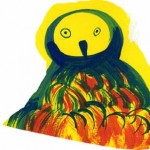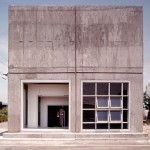Thanks to writer China Miéville (author of very good “The City & the City”) and to his article about the “50 Sci-Fi & Fantasy Works Every Socialist Should Read” I just discovered “House Taken Over”, a short story written in 1944 by Argentinean writer Julio Cortazar (better known for “La Rayuela” and “Historias de Cronopios y de Famas“) and first published in “Los anales de Buenos Aires“, a literary magazine edited by Jorge Luis Borges.
The illustrations that follow are taken from “Casa Tomada, Julio Cortazar, en traduccion al diseno de Juan Fresan, Ediciones minotauro, Buenos Aires, 1969″ (Thanks to Flickr user Iliazd)
These drawings are particularly interesting in that they are not limited to the mere translation of the narrated space into one of the possible floor-plans of the house, but they really use the floor-plan as the scenario of the narration, turning it into one of the characters of the story. In this way these illustrations represent a literary and graphic antecedent of that family of works where “theatrical staging” is itself part of the narration, (and of which we have already written about here: The Life Aquatic with Steve Zissou)


The House is the one where the narrator himself (the brother) and his sister Irene live. Aging in their quiet domestic existence, the pair has never got married: since they subsist from financial income from their farms, they don’t need to work for a living and their only household activities -dusting and cleaning the house- are concluded at eleven. The sister spends the day knitting clothing, leaving the unused garments to become moth food once stored in various parts of the house. The brother reads books, with a preference for French literature.
The house, a very large mansion the pair inherited from their grandparents, is a large building divided in two living segments. At the entrance one enters a vestibule leading to the atrium, which consists of a living room, two bedrooms on either sides and, separated by a corridor, the kitchen and a bathroom. The second half of the house, entered through a massive oak door, contains the brother’s library, three other bedrooms and a dining room. Due to the disproportions between the surface of the residence and the daily needs of the two inhabitants, the second segment is entered only for cleaning purposes or for the occasional retrieving of a book from the library.


The monotony of domestic life ends abruptly when the brother hears distinct -yet dissimilar- sounds coming from the second section of the large house. Promptly closing the door, in order to keep whatever is there from coming through, the brother tells his sister that “They’ve taken over the back part.” Although saddened by the loss of part of their belongings, the circustamce appears to the two rather unremarkable, (“happened so simply and without fuss”), like being something they were already waiting, from entities they knew would have come.
The conclusion comes ineluctable, as the mysterious entity which occupies part of the house, eventually takes over what is left (“our section”), forcing the siblings to hurriedly leave the house empty handed, locking the front door and tossing the key into the sewer.


A text like “House Taken Over” leaves many interpretations to the reader.
A political read, where the tale is seen as an antiPeronist allegory, interprets the house as no less than a metaphor for traditional Argentina. The occult forces could thus well be those sectors hitherto marginalised from the political activity; forces which are now able to progressively take over the country.
“Casa Tomada bien podría representar todos mis miedos, o quizá, todas mis aversiones; en ese caso la interpretación antiperonista me parece bastante posible, emergiendo incluso inconscientemente”. (Julio Cortázar)
“House Taken over may well represent all my fears, or perhaps all my dislikes, in which case the antiPeronist interpretation seems quite possible, even emerging unconsciously”. (Julio Cortázar)


An alternative -psychological- read looks at the analogy with the “The Fall of the House of Usher” by Edgar Allan Poe. The importance given to the spatial dimension in both short stories aims at personifying the house and turning it into a sinister character, recalling the one described by Freud in “Das Unheimliche“). The triangle among the characters is the scenario for a possible repressed incestuous relationship which passes through three phases, (unconscious, preconscious and conscious, corresponding to the three steps of the taking over of the house). Thus, what is repressed during the day emerges as night dreams, manifesting in voices and noises. As Night becomes the realm of the repressed, the flow of noises provokes frequent insomnia to the siblings. (“We had the living room between us, but at night you could hear everything in the house.“)
The ending of the story therefore represents the progressive acceptance of the emergence of the repressed, firstly in a preconscious state (symbolized by the corridor), then through the exiting of the characters to the exterior of the house, that is, to the conscience represented by the street. A hint conferming this acceptance is the first physical contact between the pair (“I took Irene around the waist (I think she was crying) and that was how we went into the street.“), an image that the proponents of this psychological hypothesis trace back to Masaccio’s “The Expulsion of Adam and Eve from the Garden of Eden“, the 1425 fresco on a wall of the Brancacci Chapel in the church of Santa Maria del Carmine in Florence.

Before leaving you to the reading of “House Taken Over” translated in English by Paul Blackburn, (here‘s the original in Castellano) we quote here China Miéville’s enthusiastic short review:
“House Taken Over: A terrifying short story undermining the notion of the house as sanctity and refuge. A subtle destruction of the bourgeois oppositions between public/private and inside/outside.”
Resources:
http://casatomadaudg.blogspot.fr/
http://noeticflux.blogspot.fr/2011/10/some-thoughts-on-cortazars-house-taken.html
http://www.taringa.net/posts/offtopic/12808889/Julio-Cortazar-Casa-Tomada-Metafora-del-Antiperonismo.html
http://esferapublica.org/nfblog/?p=2175
http://es.wikipedia.org/wiki/Casa_tomada
http://en.wikipedia.org/wiki/House_Taken_Over

“House Taken Over” (“Casa Tomada”) by Julio Cortázar
Translated by Paul Blackburn
We liked the house because, apart from its being old and spacious (in a day when old houses go down for a profitable auction of their construction materials), it kept the memories of great‐grandparents, our paternal grandfather, our parents and the whole of childhood.
Irene and I got used to staying in the house by ourselves, which was crazy, eight people could have lived in that place and not have gotten in each other’s way. We rose at seven in the morning and got the cleaning done, and about eleven I left Irene to finish off whatever rooms and went to the kitchen. We lunched at noon precisely; then there was nothing left to do but a few dirty plates. It was pleasant to take lunch and commune with the great hollow, silent house, and it was enough for us just to keep it clean. We ended up thinking, at times, that that was what had kept us from marrying. Irene turned down two suitors for no particular reason, and Maria Esther went and died on me before we could manage to get engaged. We were easing into our forties with the unvoiced concept that the quiet, simple marriage of sister and brother was the indispensable end to a line established in this house by our grandparents. We would die here someday, obscure and distant cousins would inherit the place, have it torn down, sell the bricks and get rich on the building plot; or more justly and better yet, we would topple it ourselves before it was too late.
Irene never bothered anyone. Once the morning housework was finished, she spent the rest of the day on the sofa in her bedroom, knitting. I couldn’t tell you why she knitted so much; I think women knit when they discover that it’s a fat excuse to do nothing at all. But Irene was not like that, she always knitted necessities, sweaters for winter, socks for me, handy morning robes and bedjackets for herself. Sometimes she would do a jacket, then unravel it the next moment because there was something that didn’t please her; it was pleasant to see a pile of
tangled wool in her knitting basket fighting a losing battle for a few hours to retain its shape. Saturdays I went downtown to buy wool; Irene had faith in my good taste, was pleased with the colors and never a skein had to be returned. I took advantage of these trips to make the rounds of the bookstores, uselessly asking if they had anything new in French literature. Nothing worthwhile had arrived in Argentina since 1939.

But it’s the house I want to talk about, the house and Irene, I’m not very important. I wonder what Irene would have done without her knitting. One can reread a book, but once a pullover is finished you can’t do it over again, it’s some kind of disgrace. One day I found that the drawer at the bottom of the chiffonier, replete with
mothballs, was filled with shawls, white, green, lilac. Stacked amid a great smell of camphor‐ it was like a shop; I didn’t have the nerve to ask her what she planned to do with them. We didn’t have to earn our living, there was plenty coming in from the farms each month, even piling up. But Irene was only interested in the knitting and showed a wonderful dexterity, and for me the hours slipped away watching her, her hands like silver sea‐urchins, needles flashing, and one or two knitting baskets on the floor, the balls of yarn jumping about. It was lovely.How not to remember the layout of that house. The dinning room, a living room with tapestries, the library, and three large bedrooms in the section most recessed, the one that faced toward Rodriguez Pena. Only a corridor with its massive oak door separated that part from the front wing, where there was a bath, the kitchen, our bedrooms and the hall. One entered the house through a vestibule with enameled tiles, and a wrought‐iron gated door opened onto the living room. You had to come in through the vestibule and open the gate to go into the living room; the doors to our bedrooms were on either side of this, and opposite was the corridor leading to the back section; going down the passage, one swung open the oak door beyond which was the other part of the
house; or just before the door, one could turn to the left and go down a narrower passageway which led to the kitchen and the bath. When the door was open, you became aware of the size of the house; when it was closed, you had the impression of an apartment, like the ones they build today, with barely enough room to move around in. Irene and I always lived in this part of the house and hardly ever went beyond the oak door except to do the cleaning. Incredible how much dust collected on the furniture. It may be Buenos Aires is a clean city, but she owes it to her population and nothing else. There’s too much dust in the air, the slightest breeze and it’s back on the marble console tops and in the diamond patterns of the tooled‐leather desk set. It’s a lot of work to get it off with a feather duster; the motes rise and hang in the air, and settle again a minute later on the pianos and the furniture.

I’ll always have a clear memory of it because it happened so simply and without fuss. Irene was knitting in her bedroom, it was eight at night, and I suddenly decided to put the water up for mate. I went down the corridor as far as the oak door, which was ajar, then turned into the hall toward the kitchen, when I heard something in the library or the dining room. The sound came through muted and indistinct, a chair being knocked over onto the carpet or the muffled buzzing of a conversation. At the same time, or a second later, I heard it at the end of the passage which led from those two rooms toward the door. I hurled myself against the door before it was too late and shut it, leaned on it with the weight of my body; luckily, the key was on our side; moreover, I ran the great bolt into place, just to be safe.
I went down to the kitchen, heated the kettle, and when I got back with the tray of mate, I told Irene: “I had to shut the door to the passage. They’ve taken over the back part.”
She let her knitting fall and looked at me with her tired, serious eyes. “You’re sure?”
I nodded.
“In that case,” she said, picking up her knitting again, “we’ll have to live on this side.”
I sipped at the mate very carefully, but she took her time starting her work again. I remember it was a gray vest she was knitting. I liked that vest.
The first few days were painful, since we’d both left so many things in the part that had been taken over. My collection of French literature, for example, was still in the library. Irene had left several folios of stationery and a pair of slippers that she used a lot in the winter. I missed my briar pipe, and Irene, I think, regretted the loss of an ancient bottle of Hesperidin’s It happened repeatedly (but only in the first few days) that we would close some drawer or cabinet and look at one another sadly.
“It’s not here.”

One thing more among the many lost on the other side of the house.
But there were advantages, too. The cleaning was so much simplified that, even when we got up late, nine‐thirty for instance, by eleven we were sitting around with our arms folded. Irene got into the habit of coming to the kitchen with me to help get lunch. We thought about it and decided on this: while I prepared the lunch, Irene would cook up dishes that could be eaten cold in the evening. We were happy with the arrangement because it was always such a bother to have to leave our bedrooms in the evening and start to cook. Now we made do with
the table in Irene’s room and platters of cold supper.Since it left her more time for knitting, Irene was content. I was a little lost without my books, but so as not to inflict myself on my sister, I set about reordering papa’s stamp collection; that killed some time. We amused ourselves sufficiently, each with his own thing, almost always getting together in Irene’s bedroom, which was the more comfortable. Every once in a while, Irene might say: “Look at this pattern I just figured out, doesn’t it look like clover?”
After a bit it was I, pushing a small square of paper in front of her so that she could see the excellence of some stamp or another from Eupen‐et‐Malmedy. We were fine, and little by little we stopped thinking. You can live without thinking.
(Whenever Irene talked in her sleep, I woke up immediately and stayed awake. I never could get used to this voice from a statue or a parrot, a voice that came out of the dreams, not from a throat. Irene said that in my sleep I flailed about erroneously and shook the blankets off. We had the living room between us, but at night you could hear everything in the house. We heard each other breathing, coughing, could even feel each other reaching for the light switch when, as happened frequently, neither of us could fall asleep.

Aside from our nocturnal rumblings, everything was quiet in the house. During the day there were the household sounds, the metallic click of knitting needles, the rustle of stamp‐album pages turning. The oak door was massive, I think I said that. In the kitchen or the bath, which adjoined the part that was taken over, we managed to talk
loudly, or Irene sang lullabies. In a kitchen there’s always too much noise, the plates and glasses, for there to be interruptions from other sounds. We seldom allowed ourselves silence there, but when we went back to our rooms or to the living room, then the house grew quiet, half‐lit, we ended by stepping around more slowly so as not to disturb one another. I think it was because of this that I woke up irremediably and at once when Irene began to talk in her sleep.)Except for the consequences, it’s nearly a matter of repeating the same scene over again. I was thirsty that night, and before we went to sleep, I told Irene that I was going to the kitchen for a glass of water. From the door of the bedroom (she was knitting) I heard the noise in the kitchen; if not the kitchen, then the bath, the passage off at that angle dulled the sound. Irene noticed how brusquely I had paused, and came up beside me without a word. We stood listening to the noises, growing more and more sure that they were on our side of the oak door, if not the kitchen then the bath, or in the hall itself at the turn, almost next to us.
We didn’t wait to look at one another. I took Irene’s arm and forced her to run with me to the wrought‐iron door, not waiting to look back. You could hear the noises, still muffled but louder, just behind us. I slammed the grating and we stopped in the vestibule. Now there was nothing to be heard.
“They’ve taken over our section,” Irene said. The knitting had reeled off from her hands and the yarn ran back toward the door and disappeared under it. When she saw that the balls of yarn were on the other side, she dropped the knitting without looking at it.
“Did you have time to bring anything?” I asked hopelessly.
“No, Nothing.”
We had what we had on. I remembered fifteen thousand pesos in the wardrobe in my bedroom.
Too late now.
I still had my wristwatch on and saw that it was 11 P.M.. I took Irene around the waist (I think she was crying) and that was how we went into the street. Before we left, I felt terrible; I locked the front door up tight and tossed the key down the sewer. It wouldn’t do to have some poor devil decide to go in and rob the house, at that hour and the difference with the house taken over.






Thank you for the diagram of the house. My students liked reading the story and as an assignment they had to draw their own vision of the inside of the house. I then showed them this diagram and they got a better image of what the house must have been like.
Good teaching. I’d like to see some of the results.
Take care,
f
I really enjoyed the this way to interpret the story! The plan house been taken by the letters is a mix of the frational with poetic.
I’m an architect and i work with set design. At first contact with this story, i thought something really different. Just at the third time of lecture, i propose to create a fast set design of an idea of the house starting beeing taken, and at my view it was by a lot of wool.
I think this story can be creative to anyone in many ways!
Thank you for sharing your interpretation, the stage design looks very interesting, have you got more images of it? We’d love to feature it in the blog if you agree.